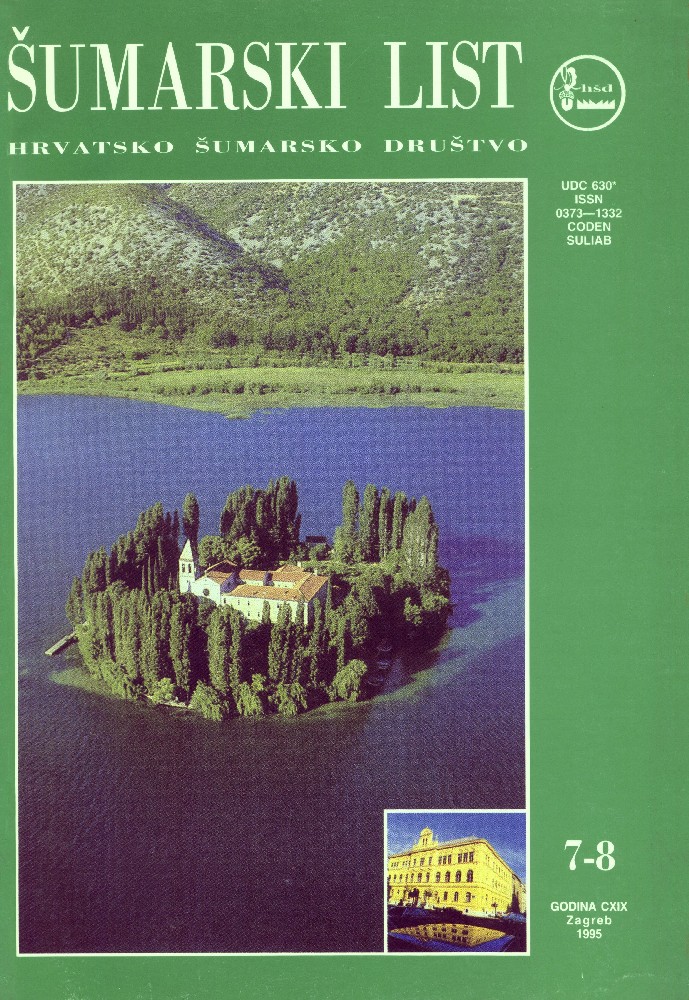
broj: 7-8/1995
pdf (13,8 MB) |
|
||||||||||||||
| B. Prpić | ||
| XX. WORLD CONGRESS IUFRO PDF HR | 221 | |
| IZVORNI ZNANSTVENI ČLANCI | ||
| Trinajstić, I. | UDK 581.9 (Quercus ilex L.) (497.13) | |
| Sintaxonomical Investigations of Holm Oak, (Quercus ilex L.) Forests in East Istria, Croatia pdf HR EN | 223 | |
| Ante TOMAŠEVIĆ | UDK 630*232.322.9 (Pinus sp.) | |
| Višegodišnji rezultati istraživanja uspjeha pošumljavanja na kršu alepskim borom (Pinus halepensis Mill.), crnim borom (Pinus nigra Arn.) i primorskim borom (Pinus pinaster Ait.) kod tri različite metode pripreme tla za pošumljavanje. pdf HR EN | 227 | |
| Sinković, T. | UDK 630*812 (Abies alba Mill.) | |
| Some Physical Properties of Juvenile and Mature Fir-Wood (Abies alba Mill.) from Zalesina pdf HR EN | 237 | |
| PRETHODNO PRIOPĆENJE | ||
| Diminić, D., Glavaš, M., Hrašovec, B. | UDK 630*449+453 (Pinus nigra) | |
| Mycoses and Insect Pests in Austrian Pine Plantations of Crikvenica — Vinodol Area pdf HR EN | 245 | |
| Summary: A health evaluation in 1993 of the five Austrian pine plantations in the Crikvenica-Vinodol region (Fig. 1.) has revealed mainly dieback of one- and two-year old shoots from the different part of crowns. In four plantations (Pališin, Vinište, Ravna strana and Ruševo) the dieback was less frequently present, but in Klenovica it has been observed with more frequent presentation. Young pines, near the sea, were more injured than other pines in the Klenovica plantation (Fig. 2.). Field observation of the mentioned five plantations showed the low frequency presence of pine processionary moth (Cnethocampa pytiocampa Schiff). Laboratory analyses of the collected samples (needles, shoots, branches and cones) showed occurrence of some mycoses and insects: Sphaeropsis sapinea (Fr.) Dyko et Sutton (Fig. 3.), Cyclaneusma niveum (Fr.) DiCosmo, Peredo et Minter, Lophodermium seditiosum Minter, Staley et Millar, Cenangium ferruginosum Fr. and Truncatella hartigii (Tub.) Stay.; Ernobius sp., Blastophagus minor Htg. (Fig. 4.) and Leucaspis sp. Among them Sphaeropsis sapinea and Ernobius sp. were the most frequent and also with significant injurious impact on the dieback of one- and two-year old pine shoots. The analysis showed that some of the shoots were attacked by Sphaeropsis sapinea, some by Ernobius sp., and some shoots both by Sphaeropsis sapinea and Ernobius sp. It has not been established if there was or was not any connection in occurrence of the mycosis and insect. Key words: Austrian pine; mycoses; insect pests; Crikvenica -Vinodol area; Croatia | ||
| PREGLEDNI ČLANCI | ||
| Figurić, M. | UDK 630*903+829(497.13) | |
| Forestry and Wood Processing - Options for Sustainable Development pdf HR EN | 253 | |
| STRUČNI ČLANCI | ||
| Tolić, I. | UDK 630*232.32 | |
| Production of Forest Planting Material in Karst Conditions pdf HR EN | 261 | |


